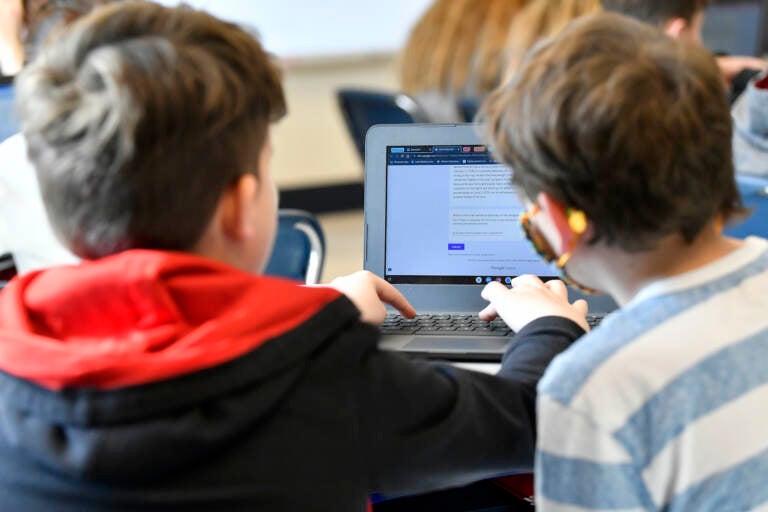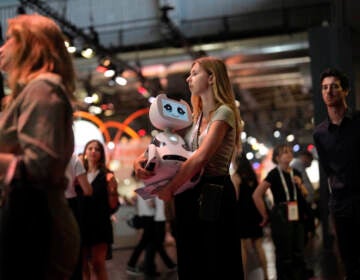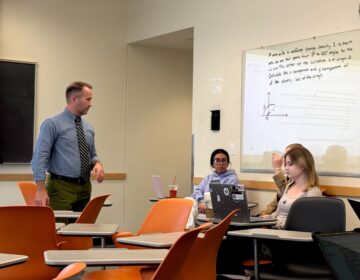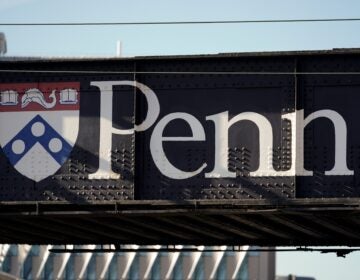ChatGPT and school instruction: Navigating between evolution and caution
The Philadelphia School District is currently limiting the use of the AI software for students until they learn more about it.

Michael Burton-Straub, left, and Declan Lewis attempt to "Find the Bot" in Donnie Piercey's class at Stonewall Elementary in Lexington, Ky., Monday, Feb. 6, 2023. Students in the class each summarized a text about boxing champion and Kentucky icon Muhammad Ali then tried to figure out which summaries were penned by classmates and which was written by the chatbot. The chatbot was the new artificial intelligence tool, ChatGPT, which can generate everything from essays and haikus to term papers in a matter of seconds. (AP Photo/Timothy D. Easley)
As Philadelphia high schools usher in a new year, educators find themselves in a tug of war between opportunity and caution with the current revolution of artificial intelligence technology and the introduction of OpenAI’s ChatGPT. The AI model is loaded with an extensive knowledge base, which presents both a promising teaching aid and a potential incentive for academic dishonesty.
The AI tool was first released in November of 2022. The app opens up a chatbox in which you can ask it anything you’d like. Ask the tool to write a paper on WWI, solve a calculus problem, summarize class notes, or even generate ideas for the next homework assignment, and it can do so in a matter of seconds.
Many states have already banned the software from their schools, while others are still trying to better understand it. The Philadelphia School District is currently limiting the use of the AI software for students until they learn more about it.
“At this time, we have no knowledge of students using ChatGPT, nor have we received any complaints from principals or teachers. The District utilizes District wide filtering solutions. ChatGPT is not currently blocked by our filtering solutions. Until the District understands more about ChatGPT, we will block this site for use in our schools or at home on our student Chromebooks,” said Monique Braxton, deputy chief of communications for the Philadelphia School District, in an email.
The use of ChatGPT in post-secondary institutions seems to be more accepted. Some college professors have even used it to their advantage, requiring it in their syllabus and pushing students to learn with it. But in a place where students are still developing fundamental critical thinking and problem-solving skills, how can this tool be utilized in a way that still promotes independent thinking?
‘Real potential’
Shiren Vijiasingam, chief product officer of Instructure, strongly believes that educators can achieve a balance between embracing innovation and ensuring academic integrity while using ChatGPT.
“I think it’s got real potential to revolutionize the way we approach education across the ecosystem of learning. It is providing a really intuitive, interactive platform for students to engage with and learn from. And so I think it’s going to fundamentally change education technology, for the better,” said Vijiasingam.
Instructure is a technology company that focuses on educational software. It is best known for its learning management system, Canvas, which provides a digital platform for teachers and students to connect and build their educational environment.
Vijiasingam has two decades of product experience and ten years in educational technology. Before joining Instructure, Vijiasingam served as the chief product officer for Newsela, another popular edtech company, and General Assembly, an education and career training company focusing on tech-related fields.
“I think the ability to adapt the output of content to multiple cognitive levels to multiple learning modes is really powerful. I think it can really help students understand complex ideas, help tame those ideas, provide feedback and support in ways that can be unique and personalized to each learner,” he said.
While some instructors in Philadelphia have their concerns about using AI in the classroom, they recognize the obligation they have to look into all options that could be of benefit to their students.
“I wouldn’t say that I’m in favor of it. I don’t really necessarily like the idea of an artificial intelligence doing young people’s work. But I would acknowledge that as a school leader, we have the responsibility to make sure that every resource that is available, young people are familiar with and have the ability to access it,” said Principal Josh Anderson of Universal Audenried Charter School in Grays Ferry.
New research conducted by Instructure and Justkul Inc. suggests that schools should consider bringing ChatGPT into the classroom. The latest July study, which surveyed 954 students, teachers, and administrators, found that:
- “Sentiment about AI is primarily positive with 54.5% of teachers, students, and administrators feeling either very positive or positive. with 29.9% staying neutral.”
- “Teachers and administrators feel AI can positively impact learning in several key areas, the top four being multilingual content (32.3%), cheating detection (30.5%), question development (29.9%), and neurodiverse content (28.5%).”
- “Respondents did feel like AI is ‘likely used sometimes’ to cheat, but on the flip side, it can also help students understand their strengths and weaknesses. To some degree, respondents felt like AI overall was more helpful than harmful and even made them feel more confident.”
- “When ranking advantages of AI in the classroom, teachers actually view AI as an opportunity to avoid missing things, make learning fun and assist in generating answers. Students, on the other hand, appreciated that AI helps them avoid mistakes, avoid missing things and help generate answers.”
The question is not whether AI will have a place in education but rather how educators and administrators can direct its integration for the best results. It is evident that the future of education will undoubtedly intertwine with technology; the task at hand is to ensure that this relationship fosters responsible learning and academic integrity.
“It’s about putting the educator in the center and supporting them with technology, not technology on its own, not technology that tries to replace the educational use case,” says Vijiasingam.
WHYY is your source for fact-based, in-depth journalism and information. As a nonprofit organization, we rely on financial support from readers like you. Please give today.





